Another ramp season has come and gone and I definitely got my share of ramps this year. Each year I learn more and more about ramps, how to find them, how to sustainably harvest them, how to cook with them. This is the year to learn more about foraging too. So far I’ve only foraged ramps and dandelions but I’m very happy with both harvests.
In years past I’ve harvested ramps, also known as wild leeks, from a lake that was near where we used to live. But now that we live right on the river, the ramps are abundant! I haven’t really done a lot of research on where to find ramps, but it seems that they like to grow near water and on the north facing side of the river. There they thrive and are found almost everywhere. I’ll talk more about how to harvest them sustainably below.
Ramps seem like they are the hottest culinary item lately. I can understand why. And you will too once you taste some of the yummy things you can make with ramps. It’s almost like your body is craving the tangy taste and hit of vitamin C after a long winter of root veggies. When I first made ramp kimchi (yes, ramp kimchi) I thought it was the best thing I’ve ever had. And that was before it went through the fermentation process! More on that below.
Let’s get down to business. What do you need to forage ramps? First you need to find them. I’m no expert but my research has shown that they grow abundantly in the Appalachian region. And they grow in deciduous forests. But as I stated above I’ve always found them in a forested area along, or near, a water source (think pond, stream, river, lake). Once you’ve found them you will need a sharp knife, a trowel-like tool, and a bag. That’s pretty much it. It doesn’t take long to harvest them. And I normally only take the leaves. This was the first year I actually took the bulbs. And I only collect one bag at a time. That way I know I’ll use that bag and not waste any. The only reason I took bulbs this year was I wanted to try my hand at pickling the bulbs.
So what are you looking for? You are looking for something that looks like a lily but smaller. They typically have 2-3 broad leaves per plant. See the first picture below. If you cut a leaf and smell it (or taste it, but only do this if you are absolutely certain you have ramps) you will get a very distinct garlic smell/taste. Again, see the first picture below for sizing of the leaves for harvesting. This was the first harvest this year on May 3rd, which is about 2 weeks later than last year. I don’t keep the best records so I checked back on my social media to see when I posted from years past. The first, early harvest is normally the best, as these ramps are pungent and give the best flavor, but you can harvest right up until the leaves start to turn yellow. The window is very short-2 or 3 weeks at best. Of course in years past I have only harvested one time. This year I harvested three times.

Cutting the leaves for the first harvest, then collecting bulbs for the second harvest, and then leaves again for the final harvest. 
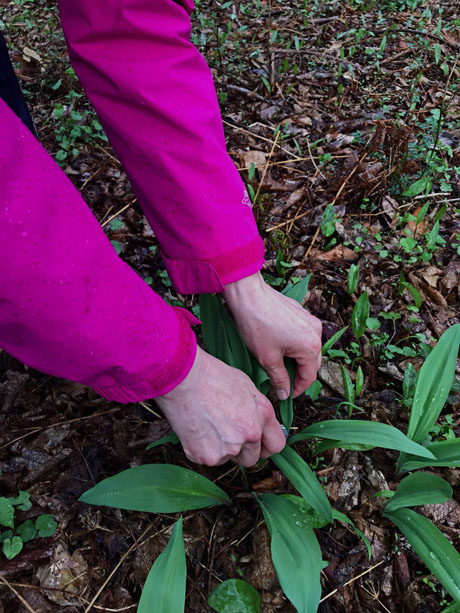
So how do you harvest them sustainably? First I only take leaves in a normal year. As I mentioned above I took bulbs the second time because I wanted to pickle them. I’ll talk more about that below. We also wanted to make ramp au gratin which requires the bulbs. We didn’t end up making that.
Look for leaves that are the biggest (so you can leave the smaller ones to grow). I think the ramps only grow so much each year meaning that they grow each year and get bigger each year, but this isn’t confirmed, just something that I’ve noticed. So look for a plant that has 2-3 leaves. Only take 1 leaf on a 2-leafed plant and only 2 leaves on a 3-leafed plant. That way you are leaving a leaf or two for further growth. When digging the bulbs, you can take the whole plant but leave the roots (I actually just read that here. I didn’t know this and unfortunately took the roots and all this year. I only harvested one bag of bulbs though). So take your sharp knife and just slice the leaves off, put in your bag, and move on to the next plant. See pictures above for examples.
To harvest the bulb, take your trowel and shovel out around the plants. At this point you would take your sharp knife and cut off the roots and leave the roots. This isn’t what I did. I took the whole plant. The bag I use is a normal sized tote bag, like the one you take to the library to tote your library books back and forth. So what is that? 8×12 or so? Not too big. You will be surprised at how many ramps fit into that sized bag. Over a pound of leaves!

This is what it looks like when you find ramps. The path is surrounded by ramps. Yes, all that green around the path are ramps! And skunk cabbage. See pic below. Do not harvest skunk cabbage. I wish there was something you could do with it but you can’t. Apparently if you eat it it could slow your heart rate down enough to kill you. So take pretty pictures but leave it in the ground. 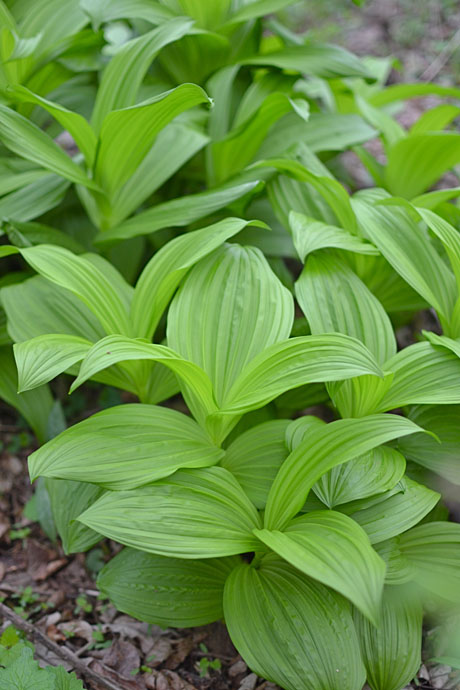

If you’re out in the woods foraging, you might as well stop and take pictures of the neat things you find along the way, such as this old hollowed out tree above. 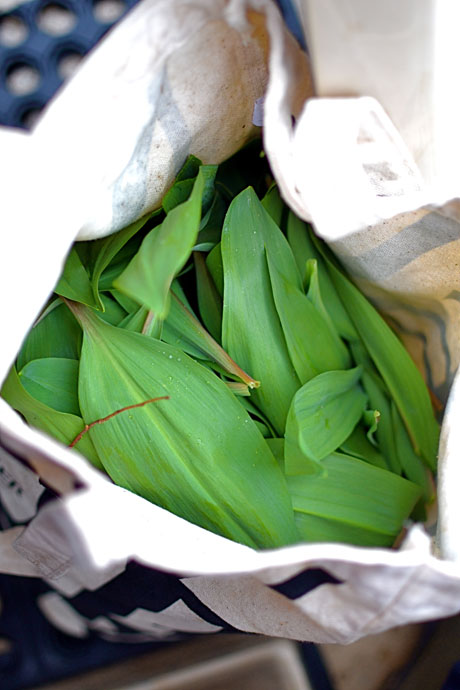
Harvest one bag at a time so you’re sure to use everything you harvested. This is especially easy if you live near the ramps and can access them easily and as often as needed. 
First harvest of bulbs, laid out to dry. You will want to soak your ramps in cold water and then carefully pick off any debris. I soaked my ramps for an hour or so. There’s no hard and fast rule here. It just depended on what I was doing at the time. They will keep in the refrigerator for a few days too before they become unusable. I think it was 4 or 5 days between harvest time, next picking, and then processing. After they soaked in cold water for an hour or so, I then cleaned off the debris and laid them out on a clean towel to dry for a bit. Then I put them back in the refrigerator in baggies until processing. We’ll go through all the fun things you can make below. 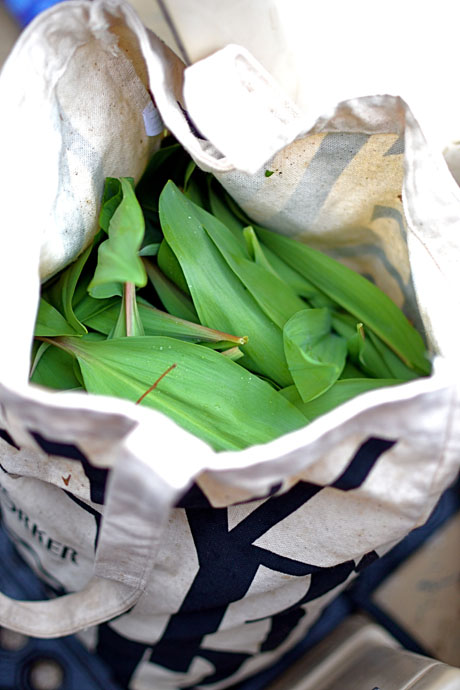
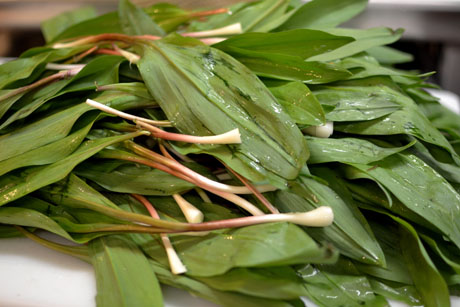
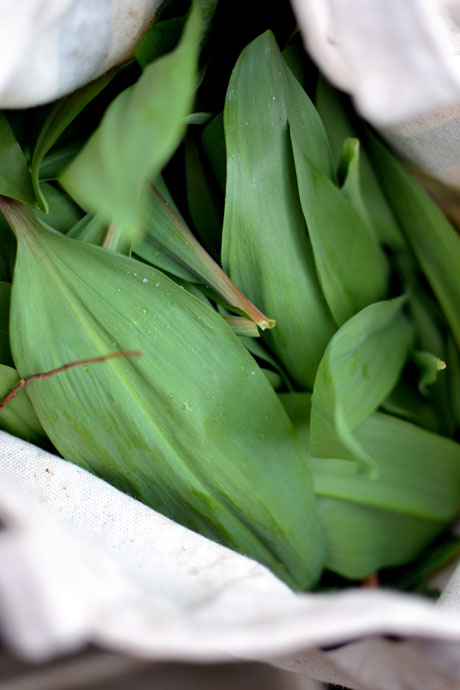
More pictures above of the harvest. But now for the fun stuff. What can you make with ramps? Just about anything! The list is endless: ramp scones, ramp biscuits, ramp pesto, ramp kimchi, ramp au gratin, pickled ramps…it feels like a scene from Forrest Gump except with ramps rather than shrimp!
I’ll walk you through ramp pesto, ramp kimchi, pickled ramps, and freezing ramp leaves. These are the things I’ve made from my ramps this year.
As I stated above, ramp kimchi is probably my most favorite thing to make with ramps. I loved it so much before fermentation that I was making a salad out of it and eating it that way. My body was craving that tangy taste of ramps mixed with the ginger, sesame oil, salt, and hot pepper. I found this recipe here, gathered my ingredients (it does have some speciality items so I had to find them at a grocery store which was no easy thing living in a rural area). It takes one pound of ramp leaves to make this recipe which then ferment down into a couple of servings. The picture below is after I first put everything together. That’s a half gallon mason jar! You can eat kimchi on anything. I had it with broccoli, bean curd, and white rice. So yummy! 
Ramp pesto is normally what I make every year. That’s normally all I make! I’m really expanding things this year! I don’t have a recipe that I follow but you can follow your favorite pesto recipe, replacing the greens with ramps, or do a quick google search for ramp pesto. This year I added in some spinach to cut the pungency of the ramps. For this years harvest I used ramp leaves, spinach (just a handful), parmesan, walnuts, salt, pepper, and olive oil. I don’t add extra garlic since the ramps are garlicky on their own. I then put the ramps in a muffin pan using an ice cream scoop and then put the pan in the freezer for a couple of days. Then I took a spoon to pop the frozen pesto out, put them in individual baggies, and back into the freezer for use later. My pesto normally lasts me the full year but I have found that the older the pesto is the less pungent it becomes so eating the pesto early on is probably better.
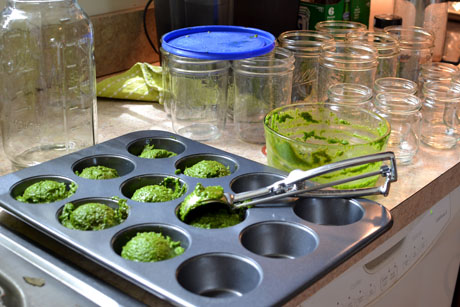
We also pickled ramps this year which is why I harvested the bulbs. I’ll be honest, it took all the bulbs to make one pint of pickled ramps. I haven’t tasted them but I don’t think I’ll do this again. Unless I taste them and they are the best thing ever. It could happen. I followed this recipe. Again, I had to find some speciality ingredients which is always hard in my rural area. I’m not going into a lot of detail here, nor do I have a picture, because I was disappointed with the small batch result. I was hoping to have enough to give as gifts and also keep a couple of jars for myself. I guess I could have used half-pint jars and gotten a couple of jars, but that still wouldn’t have been enough. And I could have gone and harvested more bulbs, but really I don’t like harvesting the bulbs. It’s less sustainable and it’s more work…umm…hello lazy forager!
All the rest of the leaves we had left, we just blanched them and put them in the freezer. The Mister did this part but it’s just normal blanching-boil some water, put the leaves in, then immediately take them out and put into cold water. Then drain the water from the leaves as much as possible. We vacuumed sealed our leaves into single serving packages. We’ll use them later for soups, stews, and anything else that we can think of.
So I’m not an expert and most of this information provided is from my own experience. You might have other recipes and ways of harvesting, or even more knowledge than I do. Please share! I will also warn you to wear long pants and sleeves when harvesting ramps. I found numerous ticks on me after each harvest. You will probably be in wooded areas where ticks love to roam. I didn’t check myself after the second harvest and ended up with a tick stuck in my arm. So please be careful. Cover yourself and then check thoroughly after foraging. Happy foraging!


mrsmotherdirt
Wow. Thats pretty awesome. I bet you could cobble together a small how-to book for foraging in your local area. We have been pulling ticks off us too. Tiny ones. Found one crawling in my daughters hair. Ugh!